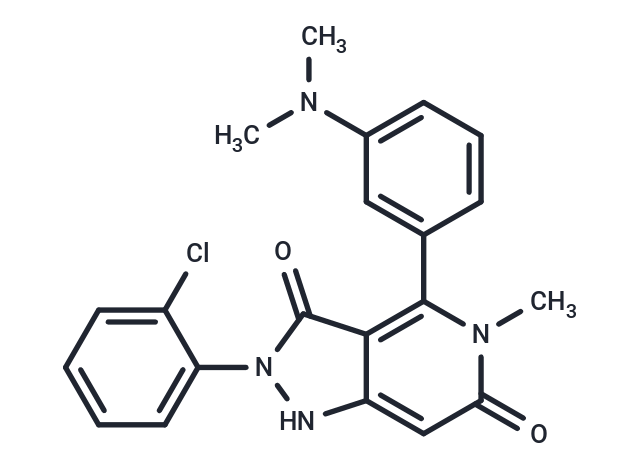Shopping Cart
- Remove All
 Your shopping cart is currently empty
Your shopping cart is currently empty

Setanaxib (GKT137831) is a potent, specific dual NADPH oxidase (NOX1/4) inhibitor.

| Pack Size | Price | Availability | Quantity |
|---|---|---|---|
| 2 mg | $34 | In Stock | |
| 5 mg | $55 | In Stock | |
| 10 mg | $97 | In Stock | |
| 25 mg | $186 | In Stock | |
| 50 mg | $335 | In Stock | |
| 100 mg | $533 | In Stock | |
| 500 mg | $1,150 | In Stock | |
| 1 g | $1,430 | In Stock | |
| 1 mL x 10 mM (in DMSO) | $61 | In Stock |
| Description | Setanaxib (GKT137831) is a potent, specific dual NADPH oxidase (NOX1/4) inhibitor. |
| Targets&IC50 | NOX1:110 nM(Ki), NOX4:140 nM(Ki) |
| In vitro | Administering 60 mg/kg of GKT137831 orally every day to mice models living in a chronic hypoxic environment mitigates long-term hypoxia-induced right ventricular hypertrophy, vascular remodeling, pulmonary cell proliferation, and alters the expression of pulmonary PPARγ and TGF-β. Similarly, daily oral administration of 60 mg/kg GKT137831 to atherosclerotic mice deficient in apolipoprotein E (ApoE) under diabetic conditions attenuates accelerated arteriosclerosis. Additionally, GKT137831 at a dosage of 60 mg/kg i.g. blocks the progression of liver fibrosis in both WT and SOD1mut mice, and reduces oxidative stress, inflammation, and fibrogenesis. Furthermore, in AngII-infused c-hNox4Tg mice, GKT137831 eradicates the increase in oxidative stress, inhibits the Akt-mTOR and NF-κB signaling pathways, and diminishes cardiac remodeling. |
| In vivo | GKT137831 can prevent oxidative stress in human aortic endothelial cells in response to hyperglycemia. It attenuates the release of H2O2, cellular proliferation, and TGF-β1 expression induced by hypoxia in HPAECs and HPASMCs, while also ameliorating the reduction in PPARγ expression. |
| Kinase Assay | Kinase Assay: IC50 of tyrosine kinase activity is measured by an enzyme-linked immunosorbent assay (ELISA) with recombinant catalytic domains of a panel of receptor and non-receptor tyrosine kinases (in some cases only part of the catalytic domain is used). Saracatinib dose ranges from 0.001-10 mM. Speci?city assays against a panel of serine/threonine kinases are performed using a ?lter capture assay with 32P. Brie?y, multidrop 384 plates containing 0.5 μL Saracatinib or controls (DMSO) alone or pH 3.0 buffer controls) are incubated with 15 μL of enzyme plus peptide/protein substrate for 5 min before the reaction is initiated by the addition of 10 μL of 20 mM Mg-ATP. For all enzymes the ?nal concentration is approximated to the Michaelis constant (Km). Assays are carried out for 30min at room temperature before termination by the addition of 5 μL orthophosphoric acid. After mixing, the well contents are harvested onto a P81 Uni?lter plate, using orthophosphoric acid as the wash buffer. Then IC50 is calculated. |
| Cell Research | Hypoxic HPASMC and HPAEC proliferation is determined using MTT assay, by Western blotting to detect proliferating cell nuclear antigen (PCNA) expression, or by manual cell counting after Trypan blue staining. Amplex Red Hydrogen Peroxide/Peroxidase Assay Kit is used to measure Water2 released into the culture media from HPAECs or HPASMCs. After exposure to control or hypoxic environments for 72 hours, Amplex Red reagent is added, and the cells are returned to control or hypoxic environments for an additional hour before fluorescence measurements. (Only for Reference) |
| Alias | GKT137831 |
| Molecular Weight | 394.85 |
| Formula | C21H19ClN4O2 |
| Cas No. | 1218942-37-0 |
| Smiles | CN(C)c1cccc(c1)-c1n(C)c(=O)cc2[nH]n(-c3ccccc3Cl)c(=O)c12 |
| Relative Density. | 1.42 g/cm3 (Predicted) |
| Storage | store at low temperature,keep away from direct sunlight | Powder: -20°C for 3 years | In solvent: -80°C for 1 year | Shipping with blue ice. | |||||||||||||||||||||||||||||||||||
| Solubility Information | DMSO: 60 mg/mL (151.96 mM) Ethanol: < 1 mg/mL (insoluble or slightly soluble) | |||||||||||||||||||||||||||||||||||
Solution Preparation Table | ||||||||||||||||||||||||||||||||||||
DMSO
| ||||||||||||||||||||||||||||||||||||

Copyright © 2015-2024 TargetMol Chemicals Inc. All Rights Reserved.